Plymouth Corporation Tramways
Summary
Plymouth Corporation took over the erstwhile Plymouth Tramways Company (owners of the Plymouth, Devonport and District Tramways) in 1892, and continued to operate horse-drawn tram services for some 15 years, until the last route was electrified in 1907. Despite the longevity of these services, and the reasonable number of photographs that have survived, good quality close-up views showing horse-tramway staff remain elusive. From the available evidence, it does, however seem reasonably clear that the corporation did not see fit to issue horsecar staff with uniforms, instead continuing what was probably the policy of the former owners. Crews therefore wore smart but informal attire, comprising: jackets, shirts and ties, along with the fashionable headgear of the day, invariably the bowler hat early on, with the flat cap predominating in later years.
Although photographs of the earliest electric services are uncommon, those that have survived show staff in single-breasted jackets with lapels, shirts and ties, wearing what appear to be peaked caps; further details are unknown. What is clear is that these uniforms (assuming they were such, rather than informal attire) were soon superseded by single-breasted jackets with five brass buttons (containing the Plymouth municipal device and full system title — see link), two hip pockets (with flap closures) and high fold-over collars; the latter bore a municipal-device badge on each side, along with an employee number in individual brass numerals. The tensioned-crown peaked caps carried a municipal-device badge, worn above a script-lettering grade badge — either 'Conductor' or 'Motorman'.
At some point, and certainly by the early 1920s, the original style of jacket was replaced, in the case of conductors by single-breasted jackets, and in the case of motormen, by double-breasted, lancer-style tunics; both styles bore epaulettes and stand-up collars. The epaulettes had a button fastening at the neck end, and bore the standard municipal-device badge, whilst the collars carried system initials — 'P C T' — on both sides. The distinction between the grades in the style of uniform was mirrored by the nearby Devonport and District Tramways, a company which Plymouth Corporation ingested in 1915. Several photos do, however, show conductors wearing lancer-style tunics, so there appears to have been some flexibility involved rather than a hard and fast delineation.
The uniform was changed one final time, probably in the 1930s, to a more modern double-breasted design with four pairs of buttons, epaulettes and lapels; the insignia remained unchanged, but was almost certainly switched from brass to chrome.
Tramcar crews were also issued with long, double-breasted greatcoats with five pairs of buttons, epaulettes and high, fold-over collars; the latter carried system initials (though in later years they were left unadorned), whilst the former probably carried the standard municipal-device badge.
Although that is known of senior staff, is that at the end of tramway operation, inspectors were wearing tensioned-crown peaked caps bearing a hat band that probably carried the grade in embroidered script lettering. No information is available on the uniforms worn, either at the end of tramway operation or earlier.
In common with the vast majority of UK tramway systems, Portsmouth employed female staff during the Great War — as conductresses — to replace male staff lost to the armed services; although these ladies apparently wore jackets, long skirts and peaked caps, photographs appear not to have survived, so further details remain unknown. Portsmouth may also have employed female staff during the Second World War, though neither documentary nor photographic evidence is available to prove this either way.
For a history of Plymouth's tramway systems, see: 'The Trams of Plymouth - a 73 Years Story' by Martin Langley and Edwina Small; Ex Libris Press (1990).
Images
Horse tram drivers and conductors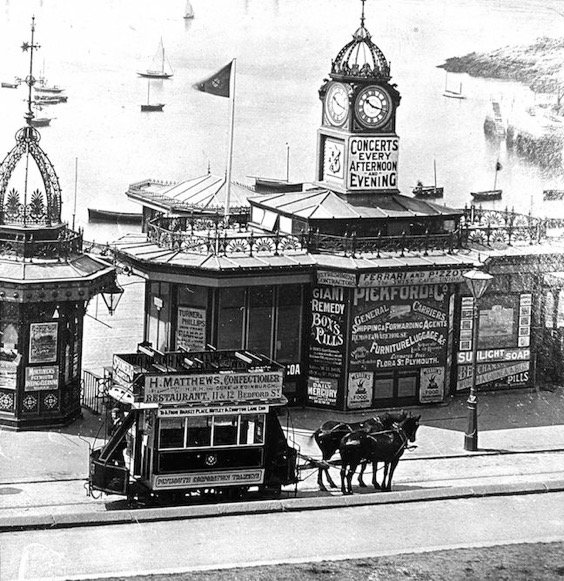
An unidentified Plymouth Corporation horse tram outside the Promenade Pier on the West Hoe route — photo undated, but probably turn of the century. Photo and background information courtesy of Derek Tait.
An enlargement of the above photograph showing the conductor, who is wearing informal attire and a flat cap.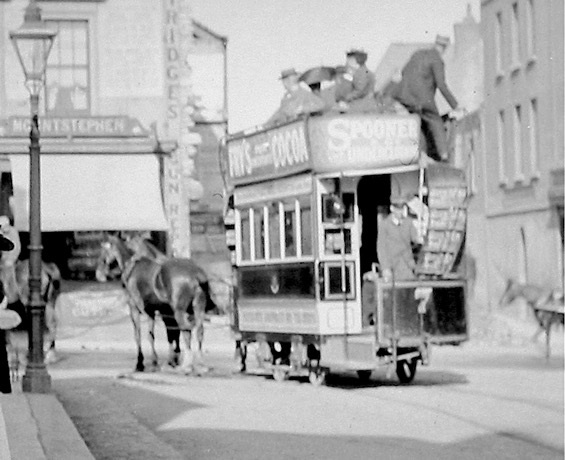
Plymouth Corporation Tramways Horsecar No 7 in Ebrington Street — photo undated, but probably turn of the century or early Edwardian. The conductor appears to be wearing informal attire. Photo and background information courtesy of Derek Tait.
Motormen and conductors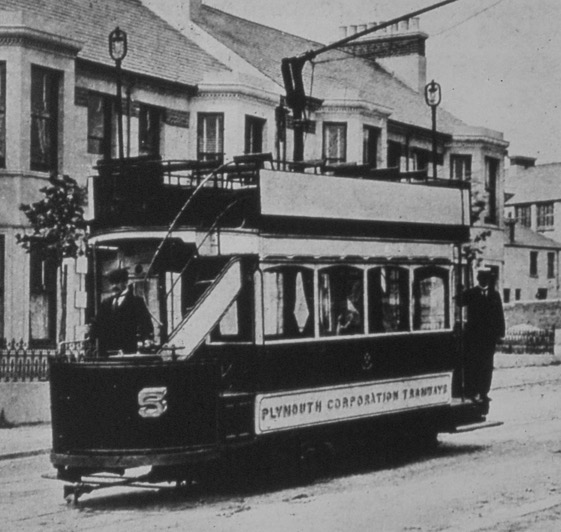
Evidently a brand-new Tramcar No 5, dating the photo to 1899 or 1900. Both men are wearing jackets with lapels, shirts and ties; it is unclear whether this was informal attire or a style of uniform that was quickly superseded. Photo courtesy of the Tramways and Light Railway Society, with thanks to David Voice.
Tramcars No 10 and 12 outside the Royal — photo undated, but probably early Edwardian. Both the crewmen are wearing single-breasted jackets of the type depicted in the studio portrait below. Photo courtesy of the Tramways and Light Railway Society, with thanks to David Voice.
Tramcar No 9 and crew at the Compton terminus with a service to the Royal Theatre — photo undated, but probably taken in the mid-to-late Edwardian era. Photo courtesy of the National Tramway Museum. 
An enlargement of the above photograph showing the conductor and the motorman. The former is wearing a single-breasted jacket with high, fold-over collars, that latter a double-breasted greatcoat.
Plymouth Corporation Tramways conductor (Employee No 42) — photo dated 12th November 1917; the subject is probably Conductor H Cornell. The cap and collar badges employ the Plymouth municipal device (see below), and were almost certainly brass to match the buttons. Author's Collection.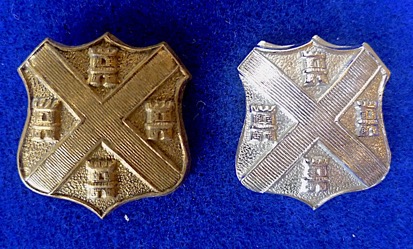
Plymouth Corporation municipal-device badges, as worn on the uniform caps and collars — brass and chrome. The brass badge would have been in use from around the turn of the century to the 1930s, after which a switch was made to chrome insignia. Author's Collection.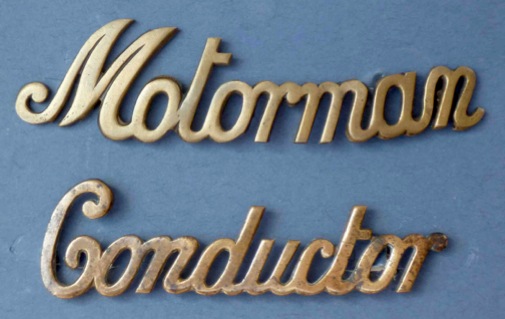
Standard, off the shelf, script-lettering cap badges of the type used by Plymouth Corporation Tramways — brass. Author's Collection.
The crew of Tramcar No 84 (an ex-Plymouth, Stonehouse and Devonport Tramways Company vehicle) pose for the cameraman at Prince Rock on 1st May 1921. Photo by R C Sambourne, courtesy of the National Tramway Museum. 
Tramcar No 24 stands at the Jepson Road terminus in Beaumont Road — photo undated, but probably taken in the early 1920s. The conductor, as well as the motorman, is wearing a lancer-style tunic rather than the usual single-breasted jacket. Photo by R C Sambourne, courtesy of the National Tramway Museum. 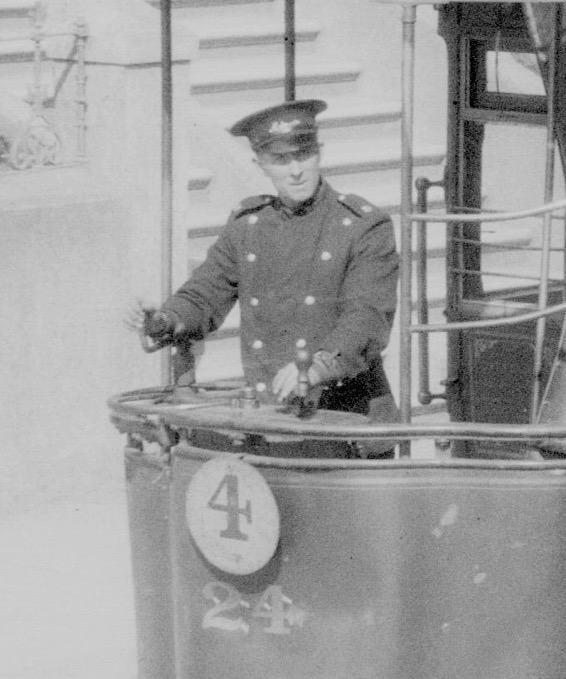
An enlargement of the above photograph showing the motorman.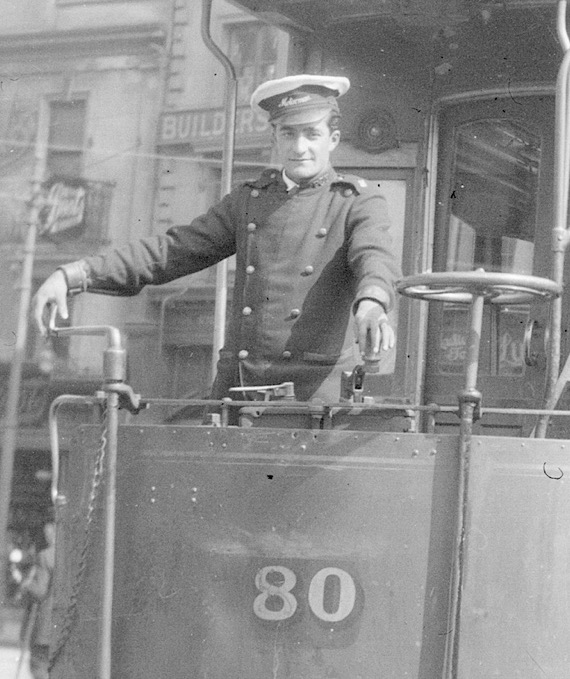
Another R C Sambourne shot, this time of a motorman at the controls of Tramcar No 80 turning out of Old Town Street into St Andrews Cross in 1920. His left-hand collar insignia are 'P C T'. Photo courtesy of the National Tramway Museum. 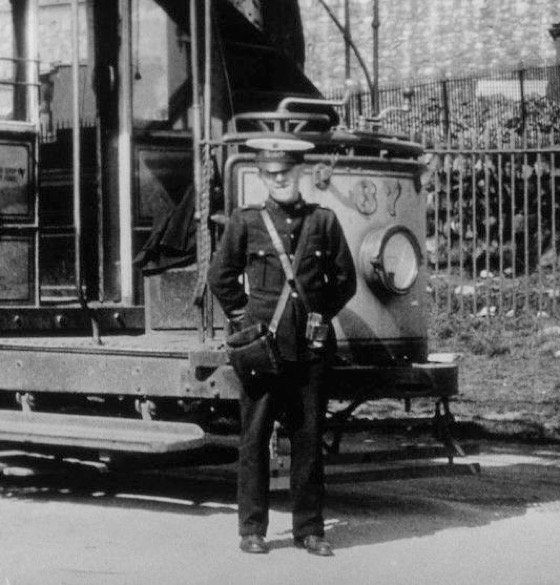
A PCT conductor with Tram No 37 on a service to Millbank via Friary — photo undated, but probably taken in the early 1920s (No 37 was withdrawn in 1924). Photo and background information courtesy of Derek Tait.
The crew of an extremely tatty-looking Tramcar No 2 – photo undated, but probably taken in the early 1920s given the condition of the vehicle and the fact that it was withdrawn in 1925. Photo by R C Sambourne, courtesy of the National Tramway Museum.
An enlargement of the above photograph showing the motorman (in uniform) and his conductor, who is wearing his own clothes.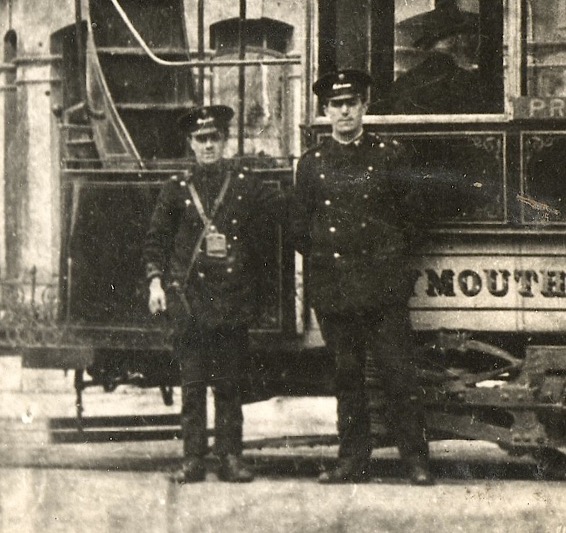
A conductor and a motorman pose with an unidentified tramcar, waiting to depart for Prince Rock and Theatre — photo undated, but from the attire of the passengers, probably taken in the early 1920s. Author's Collection.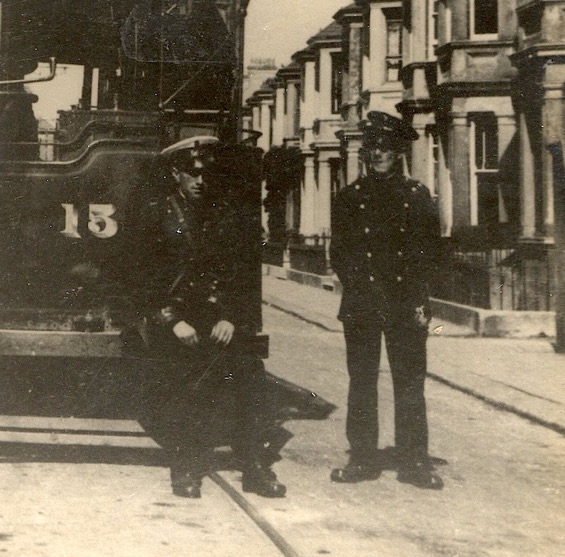
The crew of Beaumont Road-bound Tramcar No 15 take a rest — photo undated, but probably taken in the 1920s. Author's Collection.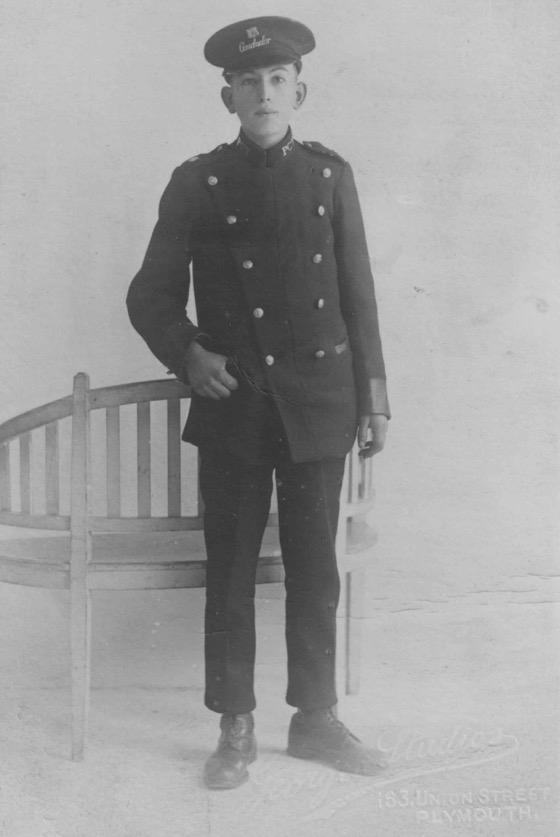
A nice, sharp portrait of a young PCT conductor taken at George's Studios, 183 Union Street — photo undated, but probably taken in the late 1920s. It is unclear whether he is a tram or bus conductor, though in all likelihood, the uniforms were identical. Author's Collection.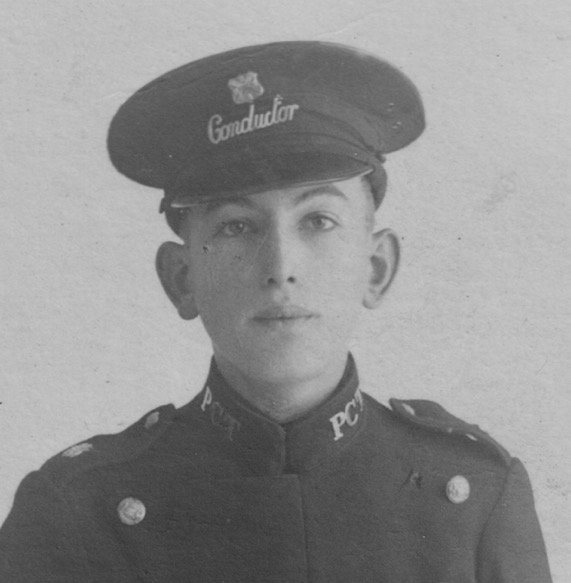
An enlargement of the above photograph showing details of the collar, epaulette and cap insignia. The buttons are of the pattern introduced after the November 1925 change of name to ‘Plymouth Corporation Tramways and Transport Department’.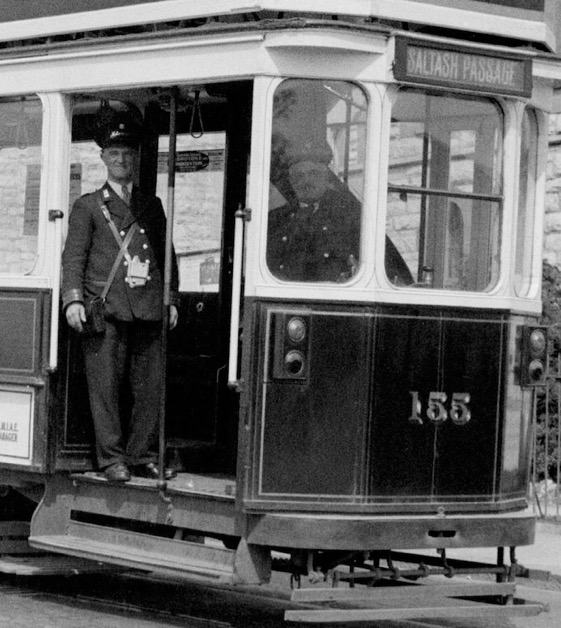
The crew of tramcar No 155 at Peverell with a service for Saltash Passage on 16th April 1938. Both men are wearing a new style of double-breasted jacket with lapels. Magnification reveals that the conductor is actually wearing a 'Motorman' script-lettering cap badge. Photo by W A Camwell, courtesy of the National Tramway Museum. 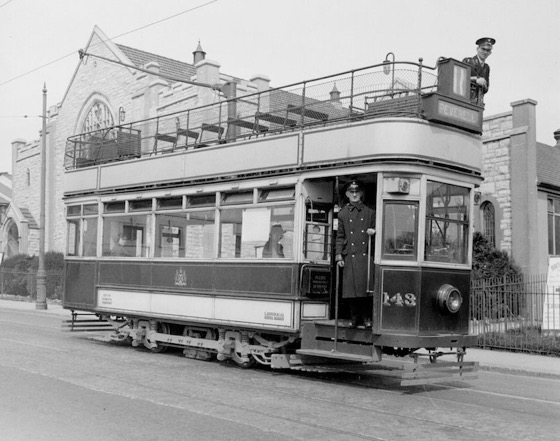
Another shot taken at Peverell on the same day as the shot of No 155 above, but this time of Tramcar No 143. Photo by W A Camwell, courtesy of the National Tramway Museum. 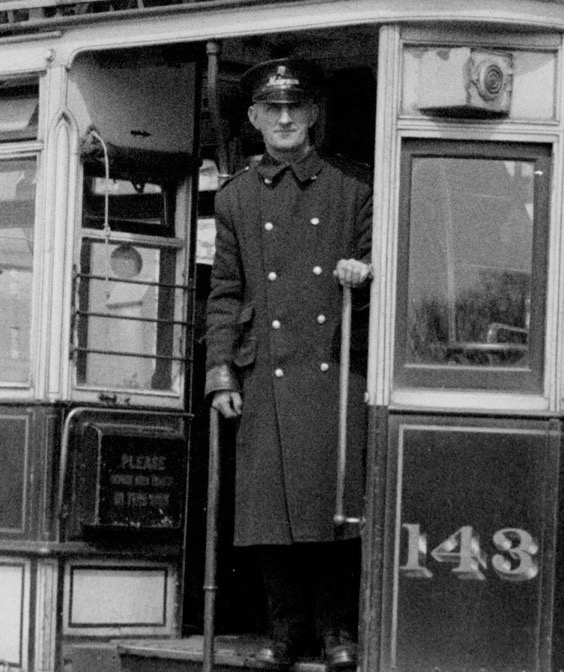
An enlargement of the above photograph showing the motorman in his greatcoat, which is devoid of insignia.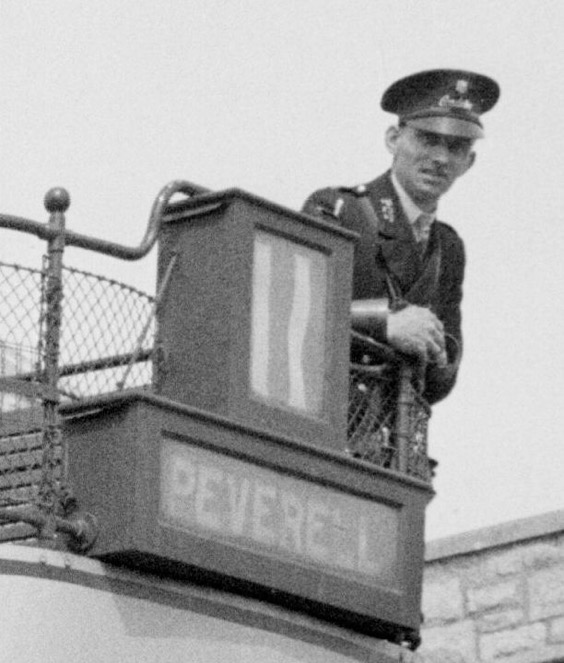
Another blow-up of the above photograph, this time showing the conductor and the last style of jacket worn.
Senior staff
An assemblage of dignataries and tramway staff with Tramcar No 158 at Milehouse depot on the 29th September 1945, the last day of tramway operation. Photo courtesy of the National Tramway Museum. 
An enlargement of the above photograph showing two senior members of staff (at the rear) who appear to be inspectors. Their tensioned-crown peaked caps appear to bear a hat band with embroidered lettering, almost certainly the grade.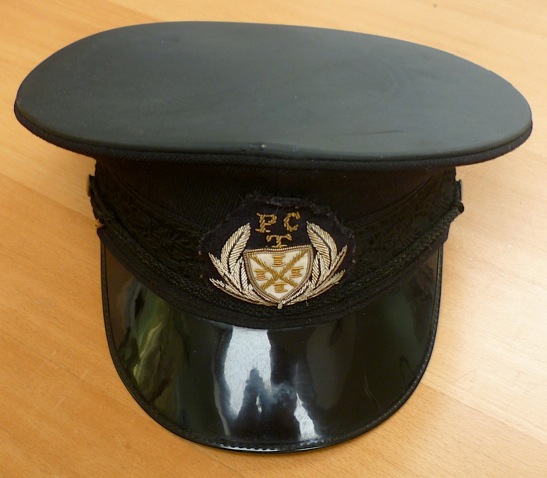
Plymouth Corporation inspector's cap. It is unclear whether this particular pattern was used in the tramway era or later. Author's Collection.